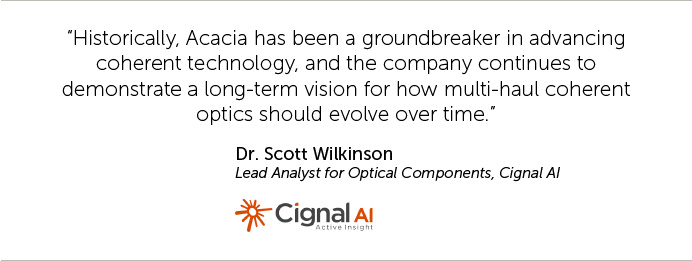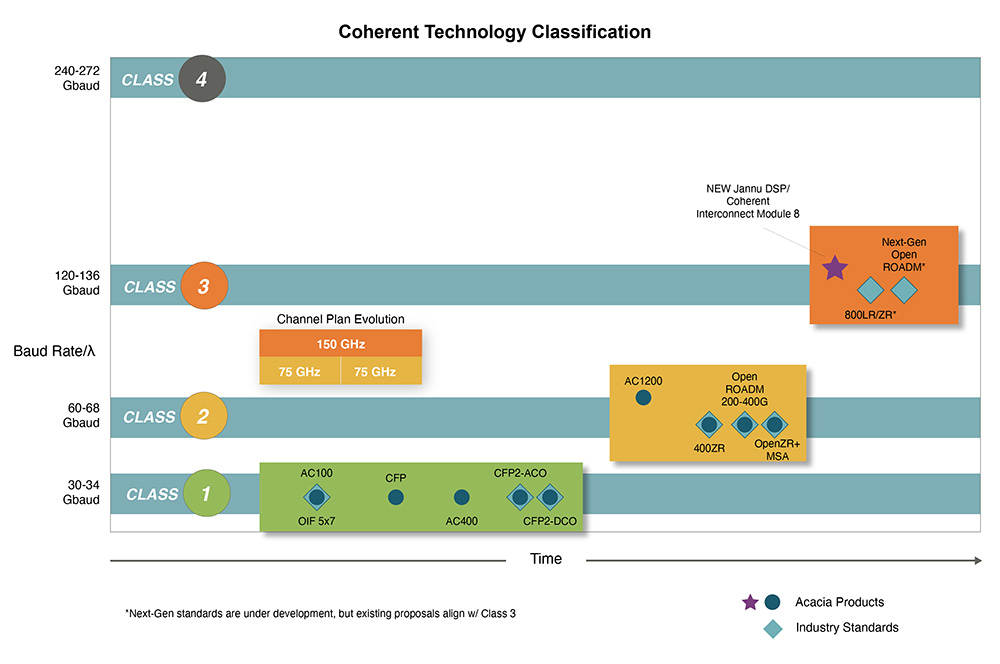1.2T Delivering Maximum Capacity, Reach & Fiber Efficiency

The Jannu DSP is designed to offer network operators the ability to maximize transmission data rate across a wide range of multi-haul network applications including DCI, metro, long-haul and subsea. “By leveraging the latest 5nm CMOS process node and our advanced signal processing algorithms, we’re delivering exceptional performance with less than half the power per bit of competing solutions, enabling a pluggable deployment model,” says Christian Rasmussen, Sr. Director, DSP and Optics Engineering and Founder at Acacia.
The Industry’s Next Class of Coherent Interconnect
The architecture of the new Coherent Interconnect Module 8 (CIM 8) solution builds upon the success of the Acacia AC1200 product family and aligns closely with the latest client data rates and coherent industry standardization efforts. The CIM 8 is designed to enable network operators to double their transmission capacity over even greater reaches. For links requiring maximum capacity, the new module can provide 1.2T capacity over a single wavelength.
“Historically, Acacia has been a groundbreaker in advancing coherent technology, and the company continues to demonstrate a long-term vision for how multi-haul coherent optics should evolve over time,” said Dr. Scott Wilkinson, Lead Analyst for Optical Components at Cignal AI. “Acacia’s new Coherent Interconnect Module is a great example of market leadership. This solution is a logical next step following the widely adopted Pico DSP-based products and will provide pluggability that is attractive to both traditional and cloud operators.”

The below figure illustrates how coherent technology has evolved in response to growing bandwidth demands. Different baud-rate classes are grouped based on technological capabilities, industry standardization (such as OIF, IEEE, Open ROADM, OpenZR+ MSA, CableLabs, ITU) and common industry investments. As the below figure depicts, the next class of coherent optical products, Class 3, enables a doubling of baud rates from the current Class 2 technology. Class 2 products include both multi-haul embedded modules and 400G faceplate pluggables where the latter was driven by standardization efforts that drove heavy investments into products centered around 16QAM, 60+Gbaud per 75GHz channel transmission.
Throughout this evolution, it has been critical that each successive class provide network architecture compatibility to the previous class, primarily reach and channel width. Acacia’s Class 3 product will support 150GHz channels with double the capacity per carrier and longer reach than that of the previous class, providing a simple, scalable path that is compatible with the previous network architecture generation.
The CIM 8 family is a Class 3 solution that can address transmission of multiple 400GbE client interfaces over virtually any network application, delivering 1.2T per carrier capacity for high-capacity DCI interfaces and 800G per carrier capacity over most optical links using 4 bits/symbol (~16QAM) modulation.
Leading in Performance and Fiber Utilization
The Jannu DSP features Acacia’s second-generation 3D Shaping technology, which leverages enhanced probabilistic constellation shaping (PCS) algorithms and Adaptive Baud Rate, a feature introduced in Acacia’s Pico DSP and widely embraced by network operators. The Jannu DSP provides customers with continuous baud rate adjustment up to 140Gbaud to optimize utilization of available spectrum in a single-span or in cascaded ROADM paths. These 3D Shaping features give service providers unprecedented transmission flexibility to match their network’s architecture, optimize fiber utilization, simplify deployment, and save on both CAPEX and OPEX.
As a single carrier design, the Jannu DSP also includes Acacia’s advanced line-rate processing algorithms to efficiently overcome fiber transmission impairments over greenfield or brownfield fiber infrastructures. These power-efficient algorithms are designed to compensate for linear and non-linear impairments, as well as provide state-of-polarization (SOP) tracking with industry leading response times. In addition, the Jannu DSP leverages Acacia’s new innovative soft-decision error correction (SD-FEC) to further enhance performance.
Scaling Optical Network Architectures

“Today is an exciting new milestone in Acacia’s history as we once again introduce an exciting new product that delivers the type of disruption needed to cost-effectively scale network capacity in the future,” said Mehrdad Givehchi, Sr. Director of Engineering for Hardware and Software and Founder at Acacia. “With every generation of product, we have been able to deliver higher transmission data rates, lower power consumption and higher performance and I am proud to see this new product carry on that legacy.”
Crossing the Pluggable Terabit Threshold with High-Density Integration
Acacia’s 3D Siliconization is a major contributing factor in how the CIM 8 can cross the terabit capacity threshold and support faceplate pluggable optics that simplify network deployment and maintenance. 3D Siliconization applies integration and 3D stacking packaging techniques to enable a single device to include all the high-speed optoelectronic functions necessary for coherent transceivers. This device decreases footprint by including the DSP, SiPh PIC, drivers, TIAs, and is manufactured using standard CMOS packaging processes that leverage the same reliability, cost, and volume scaling advantages. With 3D Siliconization, the high-speed RF interfaces are tightly coupled together, resulting in improved signal integrity for high baud rate signals.
The high-density packaging as well as an advanced high-speed modulator design provides superior frequency response that enables the 140Gbaud performance as explained in this white paper.
Acacia Technology Leadership and Vision
Transforming industry trends into a development strategy takes the kind of vision Acacia has repeatedly shown in driving the adoption of pluggable digital coherent optical (DCO) modules based on silicon photonics. However, Acacia’s silicon photonics expertise expands beyond just pluggable coherent solutions. As shown in the above figure, Acacia has previously introduced multi-haul products in previous classes. In fact, the AC400 Class 1 product was the first commercially deployed all silicon photonics-based coherent module for submarine applications and the silicon photonics-based AC1200 was the industry’s first Class 2 multi-haul solution. The newly introduced CIM 8 continues this history of technology leadership by providing industry leading performance based on the same silicon photonics used in high volume pluggable modules. In addition, Acacia is leveraging the investments being made in next-generation standardized solutions. Aligning these developments helps Acacia to accelerate time to market for both standardized and multi-haul products and benefit from the combined scale.
Acacia was a pioneer of silicon photonics for coherent applications in 2012 when it was the first coherent module vendor to envision silicon as the platform for the integration of multiple discreet photonic functions, increasing the density and reducing cost of optical interconnect products.

“Acacia’s vision and technology leadership has enabled us to transform coherent transmission. Our pioneering role in silicon photonics has led to the introduction of industry leading coherent pluggable and multi-haul solutions,” said Benny Mikkelsen, CTO and Founder of Acacia. “With every new product introduction, we have delivered the right solution at the right time to help our customers meet their growing bandwidth demands, and this new product introduction is a culmination of this proven technology leadership.”
To learn more, visit Coherent Interconnect Module 8 page or contact us.




